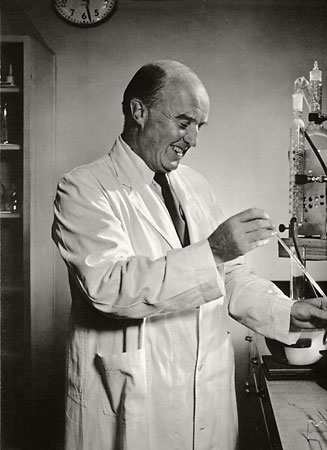Charles Herbert Best (Charles Herbert Best)

Born in West Pembroke, Washington County, Maine, he was the son of Luella Fisher and Herbert Huestis Best, Canadians from Nova Scotia. Best married Margaret Hooper Mahon in Toronto in 1924 and they had two sons. One son, Dr. Henry Best was a well-regarded historian who later became president of Laurentian University in Sudbury, Ontario. Best’s other son was Charles Alexander Best, a Canadian politician and geneticist. Best is interred in Mount Pleasant Cemetery, Toronto (section 29) not far from Sir Frederick Banting. Best moved to Toronto, Ontario in 1915 where he started studying towards a bachelor of arts degree at University College, University of Toronto. In 1918, he enlisted in the Canadian Army serving with the 2nd Canadian Tank Battalion. After the war, he completed his degree in physiology and biochemistry.
As a 22-year-old medical student at the University of Toronto he worked as an assistant to Dr. Frederick Banting and played a major role in the discovery of the pancreatic hormone insulin—one of the more significant medical advances, enabling an effective treatment for diabetes. In the spring of 1921, Banting travelled to Toronto to visit J.J.R. Macleod, professor of physiology at the University of Toronto, and asked Macleod if he could use his laboratory. Macleod was initially sceptical, but eventually agreed before leaving on holiday for the summer. Before leaving for Scotland he supplied Banting with ten dogs for experiment and two medical students, Charles Best and Clark Noble, as lab assistants.
Since Banting only required one assistant, Best and Noble flipped a coin to see which would assist Banting first. Best won and took the first shift. Loss of the coin toss proved unfortunate for Noble, given that Banting decided to keep Best for the entire summer and eventually shared half of his Nobel Prize money and a large part of the credit for the discovery of insulin. Had Noble won the toss his career might have taken a different path. In 1923, the Nobel Prize Committee honoured Banting and J.J.R. Macleod with the Nobel Prize in Medicine for the discovery of insulin, ignoring Charles Best. This incensed Banting who then chose to share half of the prize money with Best.
Best succeeded Macleod as professor of physiology at University of Toronto in 1929. During World War II he was influential in establishing a Canadian program for securing and using dried human blood serum. In his later years, he was an adviser to the Medical Research Committee of the United Nations World Health Organization.
Born
- February, 27, 1899
- USA
- West Pembroke, Maine
Died
- March, 31, 1978
- Toronto, Canada
Cemetery
- Mount Pleasant Cemetery
- Toronto, Canada


